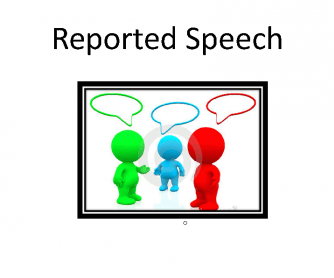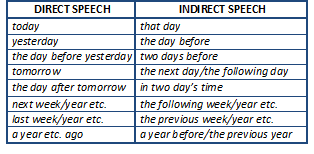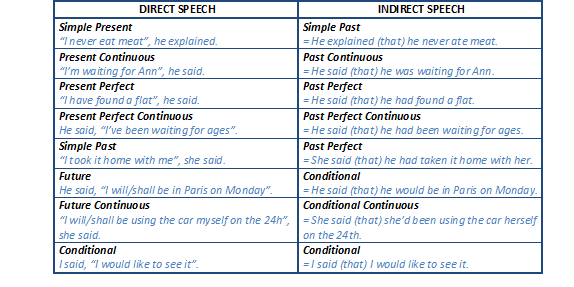

Hello, dear colleagues, next week I'm teaching my students Reported Speech, I used to practice it with sentences and examples but this time I want to do something different, that´s why I put together some games to learn it in an easier and funnier way.
First, you´ll find the theory and below that,  the games.
Hope you find these games useful and funny as I do.
Write your comments and leave me your points and If you have any activities that have worked for you, please share them!
Greetings from Argentina!

REPORTED SPEECH
DIRECT AND INDIRECT (OR REPORTED) SPEECH.
INTRODUCTION:
There are two ways of relating what a person has said: direct and indirect. In direct speech we repeat the original speaker’s exact words:
He said, “I have lost my umbrella.â€
Remarks thus repeated are placed between inverted commas, and a comma is placed immediately before the remark. Direct speech is found in conversations in books, in plays, and in quotations.
In indirect speech we give the exact meaning of a remark or a speech, without necessarily using the speaker’s exact words:
He said (that) he had lost his umbrella.
There is no comma after say in the indirect speech. that can usually be omitted after say and tell + object. But it should be kept after other verbs: complain, explain, object, point out, protest etc. Indirect speech is normally used when a conversation is reported verbally, direct speech is sometimes here to give a more dramatic effect.
When we turn direct speech into indirect, some changes are usually necessary.
PRONOUNS AND ADJECTIVES: CHANGES NECESSARY
A. First and second person pronouns and possessive adjectives normally change to the third person except when the speaker is reporting his own words:
I = he, she
me = him, her
my = his, her
mine = his, hers
we = they
She said, “he’s my sonâ€. > She said that he was her son.
“I’m illâ€, she said. > She said that she was ill.
B. THIS / THESE
This used in time expressions usually becomes ´that´.
She said, “She’s coming this weekâ€. > She said that she was coming that week.
´This ´and ´that´ used as adjectives usually change to ´the´.
He said, “I bought this pearl/these pearls for my motherâ€. >  He said that he had bought the pearl/the pearls for his mother.
´This´, ´these´ used as pronouns can become ´it´, ´they/them´.
He came back with two knives and said, “I found these beside the king’s bedâ€. > He said he had found them beside the king’s bed.
He said, “We will discuss this tomorrowâ€. >  He said that they would discuss it (the matter) the next day.
EXPRESSIONS OF TIME AND PLACE IN INDIRECT SPEECH:Â
A. Adverbs and adverbial phrases of time change as follows:

“I saw her the day before yesterdayâ€, he said. > He said he’d seen her two days before.
“I’ll do it tomorrowâ€, he promised. > He promised that he would do it the next day.
She said, “My father died a year agoâ€. > She said that her father had died a year before/the previous year.
B. But if the speech is made and reported on the same day these time changes are not necessary:
At breakfast this morning he said, “I’ll be very busy todayâ€. > At breakfast this morning he said that he would be very busy today.
C. ´Here´ can become ´there´ but only when it is clear what place is meant:
At the station, he said, “I’ll be here again tomorrowâ€. > He said that he’d be there again the next day.
Usually ´here´ has to be replaced by some phrase:
She said, “You can sit here, Tomâ€. > She told Tom that he could sit beside her.
STATEMENTS IN INDIRECT SPEECH: TENSE CHANGES NECESSARY
A. Indirect speech can be introduced by a verb in a present tense:
He says that ... This is usually when we are:
a. reporting a conversation that is still going on.
b. reading a letter and reporting what it says.
c. reading instructions and reporting them.
d. reporting a statement that someone makes very often, e.g. Tom says that he’ll never get married.
When the introductory verb is in a present, present perfect or future tense we can report the direct speech without any change of tense:
PAUL (phoning from the station): I’m trying to get a taxi.
ANN (to Mary, who is standing beside her): Paul says he is trying to get a taxi.
past tense. The changes are shown in the following table.Â

QUESTIONS IN INDIRECT SPEECH
Direct question: He said, “Where is she going?â€
Indirect question: He asked where she was going.
A. When we turn direct questions into indirect speech, the following changes are necessary:
a. tenses, pronouns and possessive adjectives, and adverbs of time and place change as in statements.
b. the interrogative form of the verb changes to the affirmative form.
c. the question mark is omitted in indirect questions.
B. If the introductory verb is ´say´, it must be changed to a verb of inquiry, e.g. ask, wonder, want to know etc.
He said, “Where is the station?†> He asked where the station was.
C. ´Ask´ can be followed by the person addressed (indirect object):
He asked, “What have you got in your bag?†> He asked (me) what I had got in my bag.
But wonder and want to know cannot take an indirect object, so if we wish to report a question where the person addressed is mentioned, we must use´ask´.He said, â€Mary, when is the next train?†> He asked Mary when the next train was.
D. If the direct question begins with a question word (when, where, who, how, why etc.) the question word is repeated in the indirect question:
He said, “Why didn’t you put on the brake?†> He asked (her) why she hadn’t put on the brake.
She said, “What do you want?†> She asked (them) what they wanted.
E. If there is no question word, if or whether must be used:
“Is anyone there?†he asked > He asked if/whether anyone was there.
COMMANDS, REQUESTS, ADVICE IN INDIRECT SPEECH
Direct command: He said, “Lie down, Tomâ€.
Indirect command: He told Tom to lie down.
Indirect commands, requests, advice are usually expressed by a verb of command/request/advice + object  + infinitive.Â
A. The following verbs can be used: advise, ask, beg, command, order, remind, tell, warn etc.
He said, “Get your coat, Tom!†> He told Tom to get his coat.
B. Negative commands, requests etc. are usually reported by not + infinitive:
“Don’t swim out too far, boysâ€, I said >  I warned/told the boys not to swim out too far.
EXCLAMATIONS IN INDIRECT SPEECH
Exclamations usually become statements in indirect speech. The exclamation mark disappears.
a. Exclamations beginning What (a) ... or How ... can be reported by:
- Exclaim/say that:
He said, “What a dreadful idea!†or “How dreadful!†> He exclaimed that it was a dreadful idea/was dreadful.
-Â Give an exclamation of delight/disgust/horror/relief/surprise etc.Â
- If the exclamation is followed by an action we can use the construction with an exclamation of delight/disgust etc. + he/she etc. + verb.
Â
b. Other types of exclamation such as Good! Marvellous! Splendid! Heavens! Oh! Ugh! etc. can be reported as in (b) or (c) above:
“Good!†he exclaimed. > He gave an exclamation of pleasure/satisfaction.
“Ugh!†she exclaimed, and turned the programme off. > With an exclamation of disgust she turned the programme off.
Â
c. Note also:
Â
He said, “Thank you!†> He thanked me.
He said, “Good luck!†>He wished me luck.
He said, “Happy Christmas!†>He wished me a happy Christmas.
He said, “Congratulations!†> He congratulated me.
He said, “Liar!†> He called me a liar.
He said, “Damn!†etc. > He swore.
The notice said: WELCOME TO WALES! > The notice welcomed visitors to Wales.
Â
YES AND NO IN INDIRECT SPEECH
´Yes´ and ´no´ are expressed in indirect speech by subject + appropriate auxiliary verb.
He said, “Can you swim?†and I said “No†> He asked (me) if I could swim and I said I couldn’t.
He said, “Will you have time to do it?†and I said “Yes†> He asked if I would have time to do it and I said that I would.
OFFERS AND SUGGESTIONS IN INDIRECT SPEECH
A. OFFERS
“Shall I bring you some tea?†could be reported ´He offered to bring me some tea.´
B. SUGGESTIONS
“Shall we meet at the theatre? could be reported ´He suggested meeting at the theatre.´
INDIRECT SPEECH: MIXED TYPES
Direct speech may consist of statement + question, question + command, command + statement, or all three together. Normally each requires its
own introductory verb.
“I don’t know the way. Do you?†he asked. > He said he didn’t know the way and asked her if she did/if she knew it.
He said, “Someone is coming. Get behind the screen.†> He said that someone was coming and told me to get behind the screen.
REPORTED SPEECH: OTHER POINTS
A. MUST: after a past reporting verb, must does not usually change:
He said, “It must be pretty late, I really must goâ€. > He said that it must be pretty late and he really must go.
´Had to´ is also possible in reported speech, but this is really the past of have to, not must.
He said, “I have to go. I have an appointment in half an hour†> He said that he had to go because he had an appointment in half an hour.
B. MODAL VERBS: Past modal verbs (could, might, ought to, should, used to, etc. ) do not normally change in reported speech.
He said, “I might comeâ€. > He said that he might come.
He said, “I would help him if I couldâ€. > He said that he would help him if he could.
He said, “You needn’t waitâ€. > He said that I needn’t wait.
Â
C. CONDITIONALS: Conditional sentences type two remain unchanged.
He said, “If my children were older I would emigrateâ€. > He said that if his children were older he would emigrate.
SAY AND TELL AS INTRODUCTORY VERBS
A. ´Say and tell´ with direct speech.
1. Say can introduce a statement or follow it.
Tom said, “I’ve just heard the newsâ€. or “I’ve just heard the newsâ€, Tom said.
Inversion of say and noun subject is possible when say follows the statement.
“I’ve just heard the newsâ€, said Tom.
say + to + person addressed is possible, but this phrase must follow the direct statement; it cannot introduce it.
“I’m leaving at onceâ€, Tom said to me.
Inversion is not possible here.
2. ´Tell´ requires the person addressed.
Tell me. He told us. I’ll tell Tom.
Except with tell lies/stories/the truth/the time, when the person addressed need not to be mentioned.
He told (me) lies. I’ll tell (you) a story.
Tell used with direct speech must be placed after the direct statement:
“I’m leaving at onceâ€, Tom told me.
Inversion is not possible with tell.
B. ´Say and tell´ with indirect speech
Indirect statements are normally introduced by say, or tell + object. Say + to + object is possible but less usual than tell + object.
He said he’d just heard the news.
He told me that he’d just heard the news.
Note also tell ... how/about:
He told us how he had crossed the mountains. He told us about crossing the mountains.
He told us about his journeys.

Play time!
Card GamesÂ
For some students, the best way to learn Reported Speech is by reading the statements they have to report. This is why we often write them on the board. Try these card games instead! For the first game, prepare a set of index card each with a direct speech statement on one side and the indirect statement on the other. Divide students into pairs. Student A picks up a card and reads the direct statement. Student B must report on what they just said. Student A checks B’s reply on the back of the card. The team with the most correct points wins.
You may also try this other, easier version. Write the direct statements on index cards and their indirect versions on another set of cards. Divide the class into two teams. Each student must pick up a card and find the matching statement. You can make this more challenging by using statements that are similar but in different tenses.
What Did They Ask You?
Ask students to brainstorm a list of people who might ask them questions: a police officer, their mother/father, a teacher, a taxi driver, etc… Then a student reports something that someone asked, without revealing who it was: This person asked me if I had my driver’s license. Students must guess it was the police officer: The police officer asked you if you had your driver’s license.
Words to Live by...Â
Give students snippets of things that famous people have said about their lives and experiences. Students read them out loud and then take turns reporting what someone said: Einstein said peace could not be kept by force. He said it could only be achieved by understanding.
Celebrity Buzz
Hand out several copies of entertainment magazines or the showbiz section of the newspaper. Students must read through them and find at least one juicy bit of celebrity gossip to report to the rest of the class: Miley Cyrus said she was officially engaged to her boyfriend. To make this into a game, ask students to withhold the celebrity’s name and have the other students guess: Which famous celebrity said she was engaged to boyfriend Liam Hemsworth?
Story Time
Take advantage of story time by asking students to report on what some of the main characters said/asked: What did the Evil Queen ask the magic mirror? She asked him who the fairest of them all was.
Student Reporter
Any budding reporters will have the chance to show off their reporting skills with this fun activity. Divide students into pairs. One student will be the reporter and the other will be someone worthy of an exclusive interview: the mayor, a famous actress, a rich entrepreneur, an Olympic athlete, etc…The celebrity answers a series of questions and the reporter reports back to the class: In an exclusive interview, the mayor promised he would rid the streets of crime.
Dear Abby
Ask each student to write Dear Abby letter asking for advice on a problem; ask them to use Reported Speech in their letter: My parents said we were moving to another country but I don’t want to move. Students then exchange letters and reply to a classmate’s problem: Don’t be afraid to tell your parents how you feel. Students get their original problem letters back and report to the class on what Dear Abby said: Dear Abby told me not to be afraid to tell my parents how I feel. With this activity, you are giving your students two opportunities to use Reported Speech.
I Heard it Through the Grapevine
One student whispers something to a classmate: I love chocolate more than anything else. This student whispers it to another: Juan said he loved chocolate more than anything else. The whispering continues through the grapevine until it reaches the last student who must then say the original statement in direct speech. If there are differences, they must find out who made the mistake: Karen said Juan loved chocolate more than life itself. - I said he loved it more than anything else.
Comic Strip Gaps
To prepare for this activity cut out comic strips from a newspaper or print some you find online. Then use some liquid paper to white out what some of the characters say in their speech bubbles. Write these lines down on separate cards. Students pick up a card and try to match it to a character: Garfield said he wanted to eat lasagna.